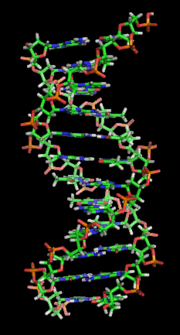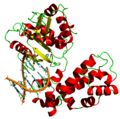A base pair (bp) is a fundamental unit of double-stranded nucleic acids consisting of two nucleobases bound to each other by hydrogen bonds. They form...
34 KB (3,942 words) - 17:28, 21 June 2025
wobble base pair is a pairing between two nucleotides in RNA molecules that does not follow Watson–Crick base pair rules. The four main wobble base pairs are...
12 KB (1,433 words) - 10:58, 21 June 2025
A Hoogsteen base pair is a variation of base-pairing in nucleic acids such as the A•T pair. In this manner, two nucleobases, one on each strand, can be...
8 KB (1,007 words) - 20:31, 26 November 2024
the new bond formed between the base and the proton is shown by an arrow that starts on an electron pair from the base and ends at the hydrogen ion (proton)...
13 KB (1,310 words) - 14:02, 17 May 2025
Nucleic acid analogue (redirect from Base analog)
among other things, different base pairing and base stacking properties. Examples include universal bases, which can pair with all four canonical bases...
49 KB (5,299 words) - 16:59, 25 May 2025
building blocks of nucleic acids. The ability of nucleobases to form base pairs and to stack one upon another leads directly to long-chain helical structures...
16 KB (1,476 words) - 20:38, 19 June 2025
Non-canonical base pairs are planar hydrogen bonded pairs of nucleobases, having hydrogen bonding patterns which differ from the patterns observed in...
89 KB (11,719 words) - 16:07, 23 May 2025
Nucleic acid double helix (section Base pair geometry)
which base pair together. In B-DNA, the most common double helical structure found in nature, the double helix is right-handed with about 10–10.5 base pairs...
46 KB (5,293 words) - 00:42, 24 May 2025
Chargaff's rules (redirect from Base-pairing rules)
percentage base pair equality: A% = T% and G% = C%. The rigorous validation of the rule constitutes the basis of Watson–Crick base pairs in the DNA double...
18 KB (1,863 words) - 22:59, 25 February 2025
DNA (section Base pairing)
two separate polynucleotide strands are bound together, according to base pairing rules (A with T and C with G), with hydrogen bonds to make double-stranded...
169 KB (18,027 words) - 17:07, 21 June 2025
Pairing-based cryptography is the use of a pairing between elements of two cryptographic groups to a third group with a mapping e : G 1 × G 2 → G T {\displaystyle...
8 KB (1,150 words) - 16:40, 25 May 2025
to the transmission speed in Mbit/s. BASE denotes that baseband transmission is used. The T designates twisted-pair cable. Where there are several standards...
34 KB (2,924 words) - 11:01, 11 June 2025
Complementarity (molecular biology) (redirect from Complementary base)
as well as regulatory functions are based on base pair complementarity. In biotechnology, the principle of base pair complementarity allows the generation...
23 KB (2,586 words) - 10:40, 20 January 2025
informational polymer consisting of xeno nucleic acids (XNA), different base pairs, using non-canonical amino acids and an altered genetic code. So far cells...
39 KB (4,541 words) - 22:19, 19 June 2025
Nucleotide (section Unnatural base pair (UBP))
oriented in opposite directions, which permits base pairing and complementarity between the base-pairs, all which is essential for replicating or transcribing...
32 KB (3,305 words) - 14:57, 23 May 2025
An au pair (/oʊˈpɛər/; pl.: au pairs) is a person working for, and living as part of, a host family. Typically, au pairs take on a share of the family’s...
62 KB (9,162 words) - 16:06, 14 June 2025
aspects of DNA. Because cytosine / guanine base-pairing is generally stronger than adenine / thymine base-pairing, the amount of cytosine and guanine in a...
29 KB (3,419 words) - 10:32, 21 June 2025
Nucleic acid secondary structure (section Base pairing)
hydrogen bonds are called a base pair (often abbreviated bp). In the canonical Watson-Crick base pairing, adenine (A) forms a base pair with thymine (T) and...
22 KB (2,690 words) - 12:55, 20 June 2025
partner strand. Genes are arranged linearly along long chains of DNA base-pair sequences. In bacteria, each cell usually contains a single circular genophore...
100 KB (10,512 words) - 03:39, 19 June 2025
Single-nucleotide polymorphism (redirect from Single base-pair polymorphism)
isoleucine)). nonsynonymous substitutions: missense – single change in the base results in change in amino acid of protein and its malfunction which leads...
58 KB (6,253 words) - 23:44, 28 April 2025
Point mutation (redirect from Base-pair substitution)
UV rays, X-rays or extreme heat, or chemical (molecules that misplace base pairs or disrupt the helical shape of DNA). Mutagens associated with cancers...
40 KB (4,856 words) - 04:49, 18 June 2025
in the sample proceeds in multiple stages: identification of the DNA base pair at specific SNP locations comparison with previously stored results interpretation...
71 KB (8,335 words) - 18:52, 18 June 2025
called the base currency or transaction currency. Currency pairs are generally written by concatenating the ISO currency codes (ISO 4217) of the base currency...
13 KB (1,785 words) - 01:20, 19 January 2025
separates genes of the same size based on their different denaturing ability which is determined by their base pair sequence. DGGE was the original technique...
12 KB (1,732 words) - 14:24, 9 June 2025
base or BASE in Wiktionary, the free dictionary. Base or BASE may refer to: BASE (mobile operator), a Belgian mobile telecommunications operator Base...
4 KB (586 words) - 02:30, 29 January 2025
called an insertion mutation) is the addition of one or more nucleotide base pairs into a DNA sequence. This can often happen in microsatellite regions due...
8 KB (940 words) - 02:53, 25 May 2025
Synthetic genomics (section Unnatural base pair (UBP))
occurring genes in its life forms. It may make use of custom designed base pair series, though in a more expanded and presently unrealized sense synthetic...
21 KB (2,186 words) - 19:02, 28 March 2025
Probalign (section Base pair probability)
accuracy alignment using partition function posterior probabilities. Base pair probabilities are estimated using an estimate similar to Boltzmann distribution...
4 KB (792 words) - 01:57, 12 April 2025
newly synthesized DNA. When an incorrect base pair is recognized, DNA polymerase moves backwards by one base pair of DNA. The 3'–5' exonuclease activity...
59 KB (7,106 words) - 00:05, 4 June 2025
each other in a bulge, or the GNRA tetraloop that has a guanine–adenine base-pair. The chemical structure of RNA is very similar to that of DNA, but differs...
66 KB (7,664 words) - 19:12, 3 June 2025


















